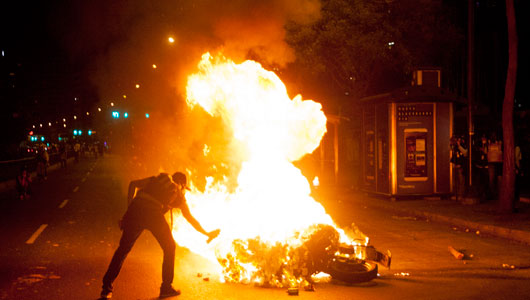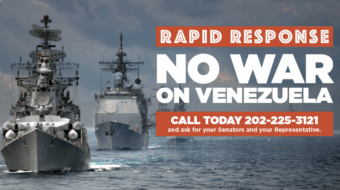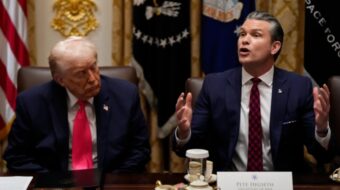
Opponents of Venezuelan President Nicolas Maduro’s socialist-inclined government have been in the streets and causing disturbances since earlier February. The course of events differs considerably from earlier campaigns directed at the “Bolivarian” governments of Maduro and President Hugo Chavez, Maduro’s predecessor who died last year.
This time an orchestrated campaign of hoarding, price-gouging, and currency manipulation set the stage for the outburst. By contrast, the failed coup attempt against Chavez in April 2002 and the following series of protests and attacks on infrastructure before and after elections seemed to come out of the blue.
The unprecedented nature of the confrontation underway now is readily apparent as the process evolves. Its two-month duration is striking. So too is the toll of victims, 39 dead and over 600 wounded. The most remarkable feature of what’s happening, however, is criminality.
Take, for example: burning the Housing Ministry and putting the lives of 200 workers at risk; vandalizing the Public Ministry (the federal prosecutor’s office), also in Caracas; cutting down 5,000 trees to make barricades; setting most of the 300 recent forest fires; 60 masked men ransacking the Environmental Ministry in Tachira; destroying Park Service facilities and equipment at the cost of $1.68 million; burning health centers, buses, and electrical substations; charging motorists tolls for bypassing barricades; stringing wire close to barricades that, unseen, injures or kills passing motorcyclists; men marching onto a university campus, brandishing Molotov cocktails and sticks, beating students, and pouring gasoline onto rescue ambulances; and, lastly, the random drive-by shooting death of Nancy Pastora Ruíz de Ortega in Valencia. She was standing in line at a government-subsidized food market. Shooters wounded four others.
The picture is reminiscent of earlier historical junctures when opposition forces, short on unity and unprepared to make good on political programming, turned to chaos. It’s the way of fascism.
Likewise in contrast to earlier confrontational situations, Venezuela’s government is promoting dialogue. President Maduro since late February has reiterated a call for a “National Peace Conference.” Regional peace conferences have taken place. On April 4, Maduro announced plans for a National Council for Human Rights aimed at investigating accusations of human rights abuses. And he proposed to the United States a bi-national commission “to promote peace and respect.”
International organizations have weighed in this time. Responding to a Venezuelan government invitation, the Union of South American Nations (UNASUR) sent a delegation of foreign ministers on two occasions to evaluate and make recommendations, most recently on April 7-8. The diplomats called for “commitment to respect all human rights,” and for peace talks. The United Nations office in Venezuela commended the government’s efforts to lessen hostilities. In early March, the Organization of American States, responding to a call from U.S. ally Panama, issued a statement expressing solidarity with the government, condemning violence, and rejecting intervention against Venezuela.
Then there is Venezuela’s western frontier: developments there are now playing into the crisis. In fact, anti-Chavez voting patterns have long characterized the western regions of Táchira, Mérida, Carabobo, Nueva Esparta, and Zulia. The first outbreaks of protests in early February took place in Tachira and Merida, in addition to wealthy districts of Caracas.
The region features a history of separatist agitation and past experience of Colombian paramilitaries crossing into Venezuela, usually on drug-trafficking missions or, in past plots to remove President Chavez. Thus on April 3 President Maduro denounced a rightist plan “for separating several states of the Republic from Venezuela.” Maduro read from a document which noted that “Fusion with Colombia is not to be rejected.”
Colombian paramilitaries reportedly once more are crossing into Venezuela, taking part in “bloody confrontations,” cutting down trees for barricades, and planning to destroy an electrical substation in Tachira. Television news commentator José Vicente Rangel, citing military intelligence sources, claimed 200 paramilitaries were waiting in Colombia’s Norte de Santander Department to cross.
Zulia is special. That small state in Venezuela’s extreme northwest accounts for 9 percent of Venezuela’s crude oil reserves, mainly in and around Lake Maracaibo. The potential is for 70 more years of extraction. Separatism has thrived there. The group “Our Own Course” and ex-Governor Manuel Rosales led that cause. Living in exile now, Rosales opposed Chavez in the 2006 presidential elections.
Official U.S. government statements and congressional maneuverings in favor of economic sanctions suggest gratification among U.S. leaders that Venezuela’s government is in trouble. Opposition demonstrations verging on the criminal, to which shortages, inflation, and President Hugo Chavez’ loss are added, do take on unprecedented seriousness. What is invariable, however, in this scenario and earlier ones is U.S. intervention. That’s why for outsiders a big part of the story henceforth must be anti-imperialist resistance from any quarter, especially from within the United States and from the international community – as well as within Venezuela.
Photo: An anti-government protester burns a motorcycle belonging to the Bolivarian National Police in the Altamira neighborhood of Caracas, Venezuela, March 31, 2014. Alejandro Cegarra/AP










